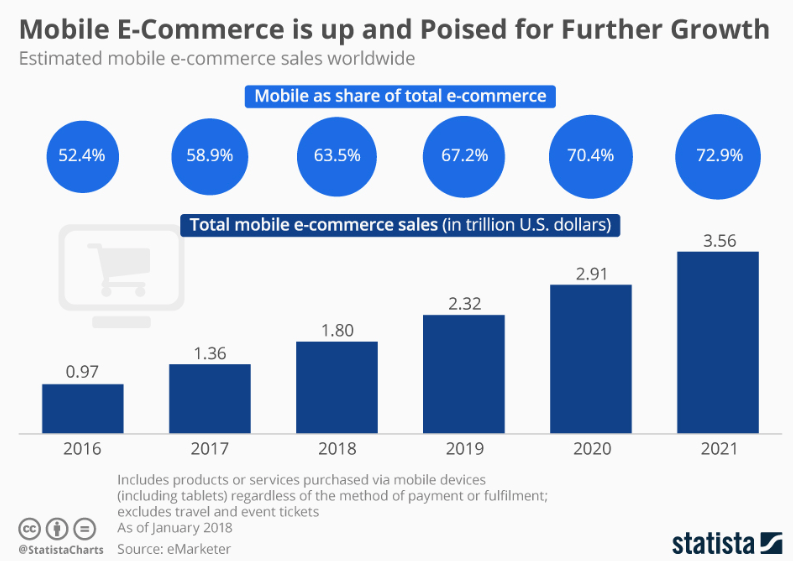Will Progressive Web Apps Replace Native Apps?
Move over native apps: Progressive web apps—PWAs—have entered the market and are here to stay. According to research firm Gartner, PWAs will replace 50% of general-purpose consumer-facing native apps by 2020.
PWAs are inherently mobile app experiences delivered via web browsers. We recently explained 5 benefits that PWAs offer versus native apps. Now, the question is this: Will PWAs eventually replace native apps altogether? Which kind of app should your brand consider?
PWAs are Great for Business
 Mobile eCommerce sales are expected to make up 72.9% of total eCommerce sales by 2021. Your sales will increasingly depend on an improved mobile experience for your potential customers.
Mobile eCommerce sales are expected to make up 72.9% of total eCommerce sales by 2021. Your sales will increasingly depend on an improved mobile experience for your potential customers.
Is your website responsive for mobile devices? Does your eCommerce site load quickly on mobile devices? Do you offer a quick and easy checkout experience? The answer to all of these questions should be “yes” if you want to remain competitive.
PWAs are fast and mobile-friendly, which results in an improved user retention rate and increased sales.
Say Goodbye to Downloads
PWAs don’t need to be downloaded from Apple’s App Store or Google Play. This allows brands to bypass not only the fees that app stores charge brands to sell the app in their marketplace but also the fees Apple and Google take off the top of all in-app purchases. When potential customers visit your website on a mobile device, the site can prompt the user with the option to “Add to Home Screen”, allowing the user to access the PWA just like they would any other app on their device.
PWAs Improve Search Engine Rankings
Security, speed, mobile-responsiveness, bounce rate—these are some of the more important ranking factors for search engines which can all be improved with a progressive web app. Also, because PWAs live on the web, Google and other search engines can crawl and rank the content that lives within the PWA.
Google actively prioritizes websites that are mobile-friendly and fast. Responsive websites tend to have a lower bounce rate which means that visitors don’t leave as quickly. PWAs also use HTTPS—Hypertext Transfer Protocol Secure—which encrypts communications over networks. The use of HTTPS is another decisive ranking factor.
Native Apps are Losing Users
According to Andrew Chen—a general partner at Andreessen Horowitz—and reported by Smashing Magazine, “the average [native] app loses 77% of users within just three days. By the time the first-month wraps, 90% of those original new users are gone.”
Why is it such a challenge for native apps to retain users? Here are a few reasons, also reported by Smashing Magazine:
- The app has a difficult onboarding process which warns the user of poor UX
- The navigation within the app is slow, sloppy, or overwhelming
- Gated content makes the app useless without payment, sending users elsewhere
- The app provides an outdated or incomplete experience
Many of the reasons that people quit using native mobile apps are design-related, but outdated software is also a critical issue and one that can be avoided by creating a progressive web app. It’s incumbent upon the user to update native apps when updates are available, but with a PWA, the updates are done on the server-end and are instantly available to all users automatically.
Deciding on Your App
Native apps are still very prevalent today, so we can’t say for sure if PWAs will replace them altogether. And while we’ve focused on progressive web apps in this blog article, there are currently many benefits to choosing a native app as well.
Allow StudioLabs a progressive web app developer to help you decide which kind of app makes the most sense for your business. Get in touch with us by filling out our contact form, and we’ll discuss what your business objectives are so that we can develop the best type of app for your company.
